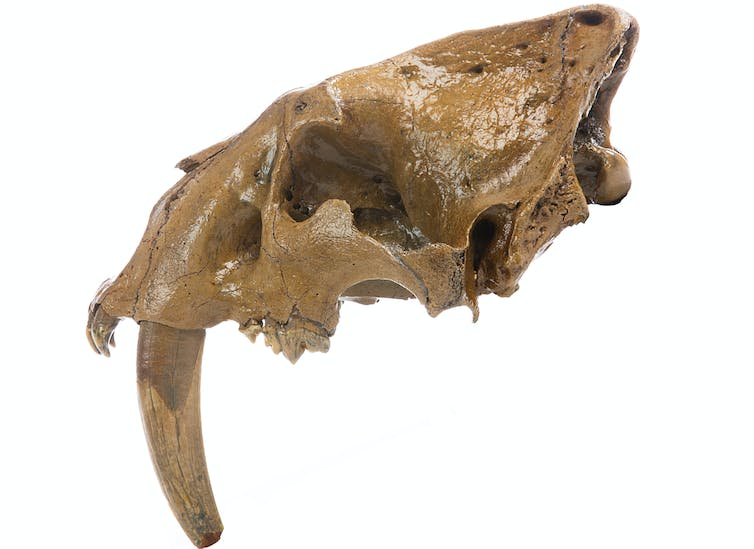The sabertooth cat is an Ice Age icon and emblem of strength, tenacity and intelligence. These animals shared the North American landscape with other large carnivores, including short-faced bears, dire wolves and the American lion, as well as megaherbivores including mammoths, mastodons, muskoxen and long-horned bison. Then at the end of the Pleistocene, between 50,000 and 10,000 years ago, they all vanished. The only place to see them now is in the fossil record.
Carnivore fossils are extremely rare, though, in comparison to those of their prey. Prey are always more abundant than predators in a healthy ecosystem. So the probability of burial, storage and discovery of carnivore bones and teeth is therefore slim compared to those belonging to herbivores.
Scientists have a relatively small and scattered inventory of sabertooth fossils. The exception comes from Rancho La Brea in downtown Los Angeles, where over 1,000 individual sabertooths were mired in tar-seep death traps.
That’s why the recent discovery of an exquisite sabertooth cat skull in southwestern Iowa is so exciting. The Smilodon fatalis skull was collected from late Pleistocene sand and gravel exposed along the East Nishnabotna River. My colleague, biologist David A. Easterla, and I are studying this specimen to learn more about the life history, prey selection and eventual extinction of this ancient predator.

The recent sabertooth find is a complete cranium, albeit missing one of its namesake sabers.
Chris Gannon, ISU News Service
Clues from a cranium
The animal’s common name – sabertooth cat – comes from its highly distinctive, saberlike canine teeth that poke out of the mouth as much as 5 or 6 inches (13 to 15 centimeters).
Sabertooths are sexually dimorphic, with males generally larger than females. The Iowa skull is larger than those of many adult males from Rancho La Brea. Several bones of the skull have not sealed together and the teeth are basically unworn, leading us to believe this individual was almost certainly a young male between 2 and 3 years old that was still growing.
We estimate he weighed 550 pounds (250 kilograms). That’s upwards of 110 pounds (50 kilograms) greater than the average adult male African lion. Given a few years to mature and fill up loose skin, he might have tipped the scale at 650 pounds (300 kilograms).
Observations of the life cycles of modern lions and tigers suggest this sabertooth was newly independent or on the cusp of independent living.

Sabertooths might have lived and hunted together in groups like modern lions – but all other modern cats live more solitary lifestyles.
jez_bennett/iStock via Getty Images Plus
However, whether sabertooths stuck together in groups or were loners is hotly debated. Disagreement revolves around just how much of a size difference there is between males and females. In many living animals, males are typically…



